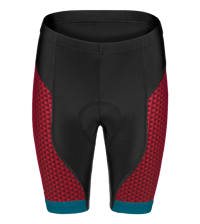Anaerobic Training
5 workout ideas and training tips to get you started

Anaerobic training stands for short workouts at a high intensity. From HIIT to strength training to running sprints - there are plenty of anaerobic exercises out there. In this article, we'll show you how to train anaerobically effectively alongwith what you need to keep in mind. We'll provide you with five specific examples and training tips so that you can get started with your anaerobic training today.
- What is Anaerobic Training?
- What happens in the body when you train anaerobically
- What are the benefits of anaerobic training?
- Where is the anaerobic zone?
- Anaerobic training: 5 examples & training tips
- High-intensity interval training (HIIT)
- Dumbbell and strength training
- Jump Training
- Anaerobic training while running
- Cycling in the anaerobic range
- On your mark, get set, go! Get started with your anaerobic training!
What is anaerobic training?
So-called "anaerobic training" is characterised by short and intensive bursts. This includes strength training, HIIT or fast sprints. The term "anaerobic" means "without air". In other words, when your body expends energy quickly, therby overloading your muscles.
In contrast, aerobic Training ("with air") focuses on moderate effort over a longer period of time - for example, moderate jogging. With aerobic training, you can maintain the effort for a long period of time; whereas, your muscles tire quickly during anaerobic training. If you train regularly in the anaerobic zone, this has the advantage that you build up muscle mass in the long term and increase your performance.
What happens in the body when you train anaerobically?
Can you remember the last time you tried to catch your breath while exercising? You probably trained in the anaerobic zone during this workout. Under normal stress, your body is in aerobic metabolism, which means that it burns fat using oxygen to produce the energy it needs.
However, if you lift weights or sprint while jogging, your muscles require more energy than the oxygen absorbed through breathing offers. The body falls back on other sources of energy to provide quickly and without the addition of oxygen. In anaerobic training, this is the burning of carbohydrates. If you are in anaerobic metabolism, large amounts of energy are available to you in the shortest possible time. But this supply is not endless as your muscles tire quickly and your strength gradually dwindles. This means you can only keep up sprints or other high-intensity exercises for a short time.
What are the benefits of anaerobic training?
In contrast to aerobic training, the body does not burn fat directly during anaerobic training, but high-intensity exercises do have some athletic benefits:
- In the long term, anaerobic training is the basis for improving performance. If you always train at the same level of intensity with the same drills, it is difficult for you to improve.
- Anaerobic training means that you build up more muscle mass over time. As muscles consume more energy than fat, you increase your calorie intake and therefore also the rate that you burn fat.
- After working out, your body begins to regenerate. This means that your body continues to burn energy even after exercising. Anaerobic training therefore indirectly boosts fat burning.
But beware: too much anaerobic training isn't always a good thing. If you train too often or for too long in the anaerobic zone, this can lead to injury and loss of performance. Therefore, don't overdo it and build in sufficient regeneration phases.
In practice, a combination of aerobic and anaerobic training is ideal. With moderate exercise, you first build up basic endurance. If you train anaerobically, on the other hand, you are constantly providing new stimuli so that your performance increases in the long term. Exactly what the ideal combination of both types of training looks like for you depends on your training level, age and other factors. Seek advice from a trusted trainer if you are unsure.
Tip: In our magazine, you'll learn about proper nutrition before and after your sport session.

Where is the anaerobic zone?
The boundary between the aerobic and anaerobic range is called the anaerobic threshold, or lactate threshold. If you train in the anaerobic zone, you are above this threshold. Within this zone, lactic acid is generated as a by-product. The lactate level in the muscles continues to rise because the substance cannot be broken down quickly enough. The result: your muscles become acidic and fatigued: In other words, you feel the burn.
Tip: You can train your anaerobic threshold. Regular training, such as interval training for example, improves aerobic efficiency. This means that the body remains in aerobic metabolism for longer. At the same time, the anaerobic threshold increases.
But how do you know that you are training anaerobically? Your heart rate gives you a rough guide: at a value of around 80 to 90 percent of your maximum heart rate, your heart rate is in the anaerobic range. This figure varies depending on fitness, age and other factors, so it should be regarded as an estimate. Professional athletes, for example, use a blood lactate measurement to precisely determine the lactate threshold - this is not necessary for amateur athletes. You can easily measure whether you are in the anaerobic heart rate range with a heart rate monitor.
Tip: You can find out which formula you can use to calculate your maximum heart rate in our magazine article on aeorbic training.
Anaerobic training: 5 examples & training tips
In principle, anaerobic training is possible in almost any sport, as long as you perform it at a high intensity. Typical examples of anaerobic training are weight training or high-intensity interval training (HIIT). At the same time, anaerobic elements can also be incorporated into classic endurance sports, such as jogging, cycling or swimming. It is always important that you build in sufficient regeneration phases so that your body can recover from the excessive strain. Also remember to incorporate a suitable warm-up before every workout - this warms up your muscles and prevents injuries.
Our recommendation: Get off to a head start with the right sportswear! In our store you'll find a large selection of individual and high-quality sportswear. Find something you like - from running jerseys to cycling shorts, there's something for everyone here.
1) High-intensity interval training (HIIT)
High-intensity interval training (HIIT) involves alternating phases of high itensity exertion followed by recovery. As a rule of thumb, you perform strength and endurance exercises at maximum intensity for a short period of time and then go into a rest phase. During the exertion phases, you normally train in the anaerobic zone - this makes you work up a good sweat. Please note that you should not do HIIT training more than two to three times a week - your muscles need sufficient recovery time.
Want to get started with HIIT today? Exercises include jumping jacks, push-ups and squats. You can find detailed information and helpful tips in our magazine - we also provide you with specific HIIT exercises to do at home.
By the way: other high-intensity sports such as boxing or many ball sports are also well suited to anaerobic training.
In the following video, you can see an example workout for anaerobic training with the HIIT method:
2) Weight and Strength Training
Regardless if you lift dumbbells in the gym or train with your own body weight. Strength exercises are a typical form of anaerobic training when performed intensively that puts your muscles under heavy strain for a short period of time.
There are many ways to do strength exercises: for example, strength training without weights, polyometric training or calisthenics.
Keep in mind: You often still feel the effects of strength training in your muscles the next day. In our magazine, we have put together the best tips to fight sore muscles for you.
3) Jump Training
The purpose of jumping power is to generate as much force as possible in a short period of time - as the name suggests, we use it to jump upwards, for example. You can perform jumping exercises, such as scissor jumps or squat jumps, both in the gym and in your own living room.

4) Anaerobic training while running
Knowledge of the anaerobic threshold is particularly useful for endurance sports such as running in order to determine your optimal training intensity. Professionals often use a mixture of aerobic and anaerobic training to increase performance and improve endurance. When running, you incorporate anaerobic training, for example by doing fast sprints or jogging uphill.
If you are a beginner runner, it is important that you first build up solid basic endurance and running technique. You can then incorporate interval training into four to five training sessions a week. For beginners, the load intervals are around 400 to 600 metres each - followed by a period of rest, where which your heart rate stabilises at around 70 percent of your maximum heart rate. You can find more information in our magazine article "Interval training running: how to build up your training correctly as a beginner".
If you are just starting out with running, our articles on learning how to jog and the right running technique will help you.
5) Cycling in the anaerobic range
Anaerobic training plays a particularly important role in road cycling. Professional athletes benefit from anaerobic endurance training, especially when riding uphill to close gaps or during the final sprint. Anaerobic elements can also be easily incorporated into existing training for amateur cyclists.
Whether at home on the ergometer or out on the bike - intervals of higher exertion help to train the anaerobic threshold and increase performance in the long term. But how do you incorporate anaerobic training into cycling? Quite simply - through short phases of higher intensity, for example by cycling faster or riding uphill. These could be 30-second sprints followed by a 30-second break, for example. It is important that you already have a certain level of basic endurance.
On your marks, get set, go! Start your anaerobic training!
Are you ready to get started? Before you get started with your anaerobic training, take a look at our shop. There you'll find comfortable, high-quality sportswear for your next workout, which you can customise in our online configurator.
If you're wondering which sport is right for you, you'll find plenty of inspiration in our magazine. Or do you already have an idea and just lack the necessary motivation? Then we recommend our article ten tips on how to motivate yourself better during training.
Image Credits: Title Image: dikushin/stock.adobe.com; Image 2: Zoran Zeremski/stock.adobe.com; Image 3: Jacob Lund/stock.adobe.com

